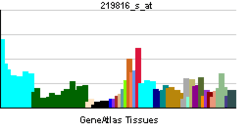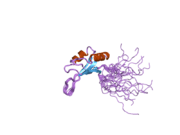RBM23
| RNA binding motif protein 23 | |||||||||||||
|---|---|---|---|---|---|---|---|---|---|---|---|---|---|
 PDB rendering based on 2cq4. | |||||||||||||
| |||||||||||||
| Identifiers | |||||||||||||
| Symbols | RBM23 ; CAPERbeta; RNPC4 | ||||||||||||
| External IDs | HomoloGene: 56796 GeneCards: RBM23 Gene | ||||||||||||
| |||||||||||||
| RNA expression pattern | |||||||||||||
 | |||||||||||||
| More reference expression data | |||||||||||||
| Orthologs | |||||||||||||
| Species | Human | Mouse | |||||||||||
| Entrez | 55147 | n/a | |||||||||||
| Ensembl | ENSG00000100461 | n/a | |||||||||||
| UniProt | Q86U06 | n/a | |||||||||||
| RefSeq (mRNA) | NM_001077351 | n/a | |||||||||||
| RefSeq (protein) | NP_001070819 | n/a | |||||||||||
| Location (UCSC) | Chr 14: 23.37 – 23.39 Mb | n/a | |||||||||||
| PubMed search | n/a | ||||||||||||
Probable RNA-binding protein 23 is a protein that in humans is encoded by the RBM23 gene.[1]
This gene encodes a member of the U2AF-like family of RNA binding proteins. This protein interacts with some steroid nuclear receptors, localizes to the promoter of a steroid- responsive gene, and increases transcription of steroid-responsive transcriptional reporters in a hormone-dependent manner. It is also implicated in the steroid receptor-dependent regulation of alternative splicing. Multiple transcript variants encoding different isoforms have been found for this gene.[1]
References
Further reading
- Maruyama K, Sugano S (1994). "Oligo-capping: a simple method to replace the cap structure of eukaryotic mRNAs with oligoribonucleotides". Gene 138 (1–2): 171–4. doi:10.1016/0378-1119(94)90802-8. PMID 8125298.
- Suzuki Y; Yoshitomo-Nakagawa K; Maruyama K et al. (1997). "Construction and characterization of a full length-enriched and a 5'-end-enriched cDNA library". Gene 200 (1–2): 149–56. doi:10.1016/S0378-1119(97)00411-3. PMID 9373149.
- Strausberg RL; Feingold EA; Grouse LH et al. (2003). "Generation and initial analysis of more than 15,000 full-length human and mouse cDNA sequences". Proc. Natl. Acad. Sci. U.S.A. 99 (26): 16899–903. doi:10.1073/pnas.242603899. PMC 139241. PMID 12477932.
- Heilig R; Eckenberg R; Petit JL et al. (2003). "The DNA sequence and analysis of human chromosome 14". Nature 421 (6923): 601–7. doi:10.1038/nature01348. PMID 12508121.
- Ota T; Suzuki Y; Nishikawa T et al. (2004). "Complete sequencing and characterization of 21,243 full-length human cDNAs". Nat. Genet. 36 (1): 40–5. doi:10.1038/ng1285. PMID 14702039.
- Gerhard DS; Wagner L; Feingold EA et al. (2004). "The Status, Quality, and Expansion of the NIH Full-Length cDNA Project: The Mammalian Gene Collection (MGC)". Genome Res. 14 (10B): 2121–7. doi:10.1101/gr.2596504. PMC 528928. PMID 15489334.
- Wan D; Gong Y; Qin W et al. (2004). "Large-scale cDNA transfection screening for genes related to cancer development and progression". Proc. Natl. Acad. Sci. U.S.A. 101 (44): 15724–9. doi:10.1073/pnas.0404089101. PMC 524842. PMID 15498874.
- Dowhan DH; Hong EP; Auboeuf D et al. (2005). "Steroid hormone receptor coactivation and alternative RNA splicing by U2AF65-related proteins CAPERalpha and CAPERbeta". Mol. Cell 17 (3): 429–39. doi:10.1016/j.molcel.2004.12.025. PMID 15694343.
- Stelzl U; Worm U; Lalowski M et al. (2005). "A human protein-protein interaction network: a resource for annotating the proteome". Cell 122 (6): 957–68. doi:10.1016/j.cell.2005.08.029. PMID 16169070.
- Olsen JV; Blagoev B; Gnad F et al. (2006). "Global, in vivo, and site-specific phosphorylation dynamics in signaling networks". Cell 127 (3): 635–48. doi:10.1016/j.cell.2006.09.026. PMID 17081983.
| |||||||||||

